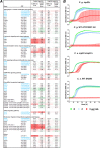Disruption of Membrane Integrity by the Bacterium-Derived Antifungal Jagaricin
- PMID: 31235622
- PMCID: PMC6709453
- DOI: 10.1128/AAC.00707-19
Disruption of Membrane Integrity by the Bacterium-Derived Antifungal Jagaricin
Abstract
Jagaricin is a lipopeptide produced by the bacterial mushroom pathogen Janthinobacterium agaricidamnosum, the causative agent of mushroom soft rot disease. Apart from causing lesions in mushrooms, jagaricin is a potent antifungal active against human-pathogenic fungi. We show that jagaricin acts by impairing membrane integrity, resulting in a rapid flux of ions, including Ca2+, into susceptible target cells. Accordingly, the calcineurin pathway is required for jagaricin tolerance in the fungal pathogen Candida albicans Transcriptional profiling of pathogenic yeasts further revealed that jagaricin triggers cell wall strengthening, general shutdown of membrane potential-driven transport, and the upregulation of lipid transporters, linking cell envelope integrity to jagaricin action and resistance. Whereas jagaricin shows hemolytic effects, it exhibited either no or low plant toxicity at concentrations at which the growth of prevalent phytopathogenic fungi is inhibited. Therefore, jagaricin may have potential for agricultural applications. The action of jagaricin as a membrane-disrupting antifungal is promising but would require modifications for use in humans.
Keywords: Candida albicans; calcium influx; jagaricin; membrane integrity; mode of action; pathogenic fungi; susceptibility testing.
Copyright © 2019 American Society for Microbiology.
Figures









References
-
- Brown GD, Denning DW, Gow NA, Levitz SM, Netea MG, White TC. 2012. Hidden killers: human fungal infections. Sci Transl Med 4:165rv113. - PubMed
-
- Chrispeels MJ, Sadava DE. 2003. Plants, genes, and crop biotechnology, 2nd ed Jones & Bartlett Publishers, Sudbury, MA.
Publication types
MeSH terms
Substances
LinkOut - more resources
Full Text Sources
Molecular Biology Databases
Miscellaneous

